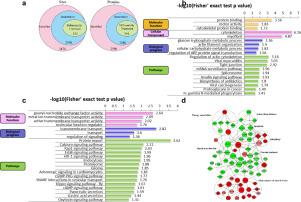Journal of Proteomics ( IF 2.8 ) Pub Date : 2020-07-28 , DOI: 10.1016/j.jprot.2020.103866 Hongzhuan Shi 1 , Jia Wang 1 , Fei Liu 1 , Xiangjing Hu 2 , Yiming Lu 2 , Shimeng Yan 1 , Daoxin Dai 1 , Xibin Yang 2 , Zaibiao Zhu 1 , Qiaosheng Guo 1

|
Hibernation is an energy-saving and adaptive strategy adopted by leech, an important medicinal resource in Asia, to survive low temperature. Reversible protein phosphorylation (RPP) plays a key role in the regulation of mammalian hibernation processes but has never been documented in freshwater invertebrate such as leech. In this study, we detected the effects of hibernation on the proteome and phosphoproteome of the leech Whitmania pigra. A total of 2184 proteins and 2598 sites were quantified. Deep-hibernation resulted in 85 up-regulated and 107 down-regulated proteins and 318 up-regulated and 204 down-regulated phosphosites using a 1.5-fold threshold (P<0.05). Proteins involved in protein digestion and absorption, amino acid metabolism and N-glycan biosynthesis were significantly down-regulated during deep-hibernation. However, proteins involved in maintaining cell structure stability in hibernating animals were up-regulated. Differentially phosphorylated proteins provided the first global picture of a shift in energy metabolism, protein synthesis, cytoprotection and signaling during deep hibernation. Furthermore, AMP-activated protein kinase and protein kinase C play major roles in the regulation of these functional processes. These data significantly improve our understanding of the regulatory mechanisms of leech hibernation processes and provides substantial candidate phosphorylated proteins that could be important for functionally adapt in freshwater animals.
Significance
The leech Whitmania pigra as an important medicinal resource in Asia is an excellent model freshwater invertebrate for studies of environmentally-induced hibernation. The present study provides the first quantitative proteomics and phosphoproteomic analysis of leech hibernation using isobaric tag based TMT labeling and high-resolution mass spectrometry. These data significantly improve our understanding of the regulatory mechanisms when ectotherm animals face environmental stress and provides substantial candidate phosphorylated proteins that could be important for functionally adapt in freshwater animals.
中文翻译:

蛋白质组和磷酸化蛋白质组分析揭示了淡水水ech(Whitmania pigra)冬眠的调节机制。
休眠是亚洲重要的药用资源水ech采用的一种节能和适应性策略,可以在低温下生存。可逆蛋白磷酸化(RPP)在调节哺乳动物的冬眠过程中起着关键作用,但从未在淡水无脊椎动物(例如水ech)中得到记录。在这项研究中,我们检测到休眠对水Whit Whitmania Pigra的蛋白质组和磷酸化蛋白质组的影响。总共定量了2184个蛋白质和2598个位点。深度冬眠导致使用1.5倍阈值的蛋白上调了85种,蛋白下调了107种,318种上调的磷酸酯和204种下调的磷酸酯(P<0.05)。在深度冬眠期间,参与蛋白质消化和吸收,氨基酸代谢和N-聚糖生物合成的蛋白质显着下调。但是,参与维持冬眠动物细胞结构稳定性的蛋白质被上调。差异磷酸化的蛋白质提供了深度冬眠过程中能量代谢,蛋白质合成,细胞保护和信号转导的全球概况。此外,AMP激活的蛋白激酶和蛋白激酶C在调节这些功能过程中起主要作用。这些数据显着改善了我们对水ech冬眠过程调控机制的理解,并提供了可能对淡水动物的功能适应重要的重要候选磷酸化蛋白。
意义
水蛭蚂蟥皮格拉作为亚洲重要的药用资源是环境诱发冬眠研究的优秀典范淡水无脊椎动物。本研究使用基于等压标记的TMT标记和高分辨率质谱技术,为水le冬眠提供了首个定量蛋白质组学和磷酸化蛋白质组学分析。这些数据极大地改善了我们对等温动物面对环境压力时的调节机制的理解,并提供了可能对淡水动物的功能适应至关重要的大量候选磷酸化蛋白。











































 京公网安备 11010802027423号
京公网安备 11010802027423号